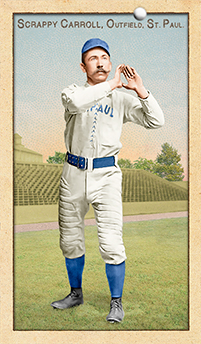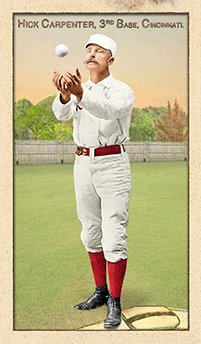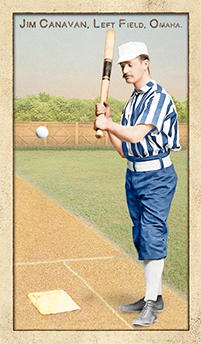
- Series: Beginnings: 1880's
- City: St. Paul
- Team: Apostles
- League: Western Association
John E. Carroll (1860-1942) began in MLB with the Union Association’s St. Paul White Caps in September 1884. The outfielder played in all nine games of the franchise’s only “season” going 3 for 31 with five errors. In ‘85, after stints with two minor-league clubs, Scrappy got a chance with the Buffalo Bisons of the NL. His .097 average fell when he went 3 for 41 in 13 games. Following time with the Utica Pent Ups, Carroll got his last chance in the majors with Cleveland’s Blues of the AA where he hit .199 in 57 games. His career average of .171 sent Scrappy permanently back to the minors. Old Judge misidentified one of his poses as being a Chicago Colts’ player, confusing him with Cliff Carroll.
- Carroll debuted in Cleveland on the city’s first Sunday game, August 3, 1887. He may or may not have innovated sunglasses, but he was noted for catching the attention of “the kranks” for donning “colored spectacles” one sunny day
- As so many before and since, Carroll had much more success in the minors, once even leading the Western League in home runs

- Series: Beginnings: 1880's
- City: Cincinnati
- Team: Red Stockings (AA)
- League: American Association
Warren William Carpenter (1855-1937) was a solid-hitting, left-handed third baseman in the days when teams and leagues were figuring out modern baseball. “Old Hickory” began with the Syracuse Stars of Al Spalding’s League Alliance, a 28-team consortium that pioneered minor-league affiliation in 1877. He stayed the next year as the club joined the International League and made his MLB debut in ‘79 when the franchise became part of the National League. Two more NL clubs followed before Hick came into his own with the American Association’s Cincinnati Red Stockings from ‘82-89. His first season at Cincy was a great one as Carpenter led the league in hits & RBI with a .342 AVG. Over a twelve-year career Hick batted .259, collecting 1,200+ hits.
- Carpenter & Jimmy Macullar traveled to Cuba after the 1879 season, becoming the first North Americans to play in the Cuban League
- The lads’ Cuban League Colón club was so dominant that other teams refused to keep playing them

- Series: Beginnings: 1880's
- City: Omaha
- Team: Omahogs
- League: Western Association
James Edward Canavan (1866-1949) began in the major leagues during the 1891 season, playing more games for “King” Kelly’s Cincinnati “Killers” (aka “Porkers”) than any other team member. As the shortstop, Jim didn’t have a great average (.228) but he drove in the most runs, proving his clutch nature. Later that year, after the Killers were dissolved, Canavan and four others moved to Milwaukee. Canavan began and ended his pro-ball career in his native New England, beginning in New Hampshire and closing out his time in hometown New Bedford, playing and managing for the Whalers. After his rookie year, Jim played for Cap Anson’s Chicago Colts, then returned to the Queen City with the Reds before ending his big league tenure as a Brooklyn Bridegroom in 1897.
- Canavan piloted his New Haven Blues to the Connecticut State League pennant in 1902
- Captured here by the Old Judge photographers while with Omaha in 1889, Jim had a good year: 10 HRs, 93 Runs & 75 SBs in just 116 games
- Jim's uniform color on this card was changed in February, 2017 from red/white/black to blue/white/blue to reflect recent reliable research by Craig Brown & friends at Threads of Our Game. Five cards had been previously released featuring a red/white/black uniform.

- Series: Beginnings: 1880's
- City: Indianapolis
- Team: Hoosiers (NL)
- League: National League
John Patrick Parnell Cahill (1865-1901) never did much damage to major league pitching but he hit well in the minors. Patsy’s brief stint in the big leagues included stops in Columbus, St. Louis and Indianapolis where the outfielder’s average was an anemic .205. A broken ankle with the Buckeyes ended his rookie season and may have been an omen that this gutty player belonged home in California. He had some great seasons out West, and the story gets retold that Ernest Thayer was so impressed by Patsy’s presence at the plate in a Stockton contest that he penned “Casey at the Bat” with him in mind. (The classic poem was published in 1888, the year before Cahill made it back to his home state). Patsy concluded his pro-ball in Texas with the Fort Worth Panthers in 1896.
- Cahill was versatile, even pitching several games and has been noted to have been part of the game’s first four-man rotation (for Columbus in ‘84 alongside the original “southpaw” Ed Morris)

- Series: Diamond Heads '15
- City: Philadelphia
- Team: Phillies
- League: National League
Clifford Carlton Cravath (1881-1963) was the “home-run king of baseball” before being deposed by the Babe. His nickname derived from the seagull (gaviota in Spanish) he supposedly killed in flight during a PCL game for the Angels. Cravath labored in the obscurity of West Coast ball for 5 years before getting the call to Boston in 1908. His lack of speed offset his batting strength and he was sold to the White Sox that season and bounced back into the minors until he caught on at age 31 with the Phillies, becoming the leading power hitter of the Deadball Era. Led the Phils to their first pennant in 1915 and led the NL in HRs six times.
- Ruth broke Cravath’s career HR record in 1921
- In the ’15 Series, his manager inexplicably gave him the bunt sign with the bases loaded and no outs, leading to a double-play grounder to the pitcher
- Said to have caused a rule change by intercepting the ball in a rundown, hurling it into the stands, and scoring. Baseball decided to stop allowing that




